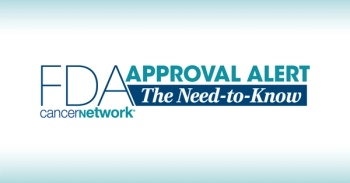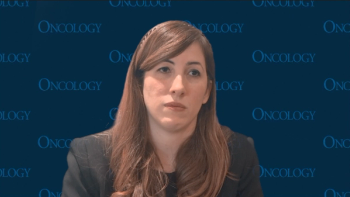
Tarlatamab and DLL3 May Open New Opportunities in SCLC Management
The field is just beginning to open the door for cellular therapy in lung cancer and other solid tumors, according to Daniel R. Carrizosa, MD, MS, FACP.
Although treatment for small cell lung cancer (SCLC) has seen minimal changes over the past 30 years, DLL3 holds promise as an actionable biomarker for novel cellular therapy agents such as tarlatamab-dlle (Imdelltra), according to a presentation by Daniel R. Carrizosa, MD, MS, FACP, at the 2025 National Immune Cell Effector Therapy Conference.1 Carrizosa is an associate professor of cancer medicine at Wake Forest School of Medicine, associate program director of the Hematology/Oncology Fellowship at Levine Cancer Institute/Carolinas Medical Center, and senior assistant director of community outreach and engagement at Wake Forest Baptist Comprehensive Cancer Center.
Carrizosa outlined the current disease landscape by describing how SCLC accounts for approximately 10% to 15% of all lung cancer cases. He noted that treatment may become complicated based on a propensity for early metastasis among patients with SCLC, with other significant challenges including limited treatment options and high recurrence rates.
Carrizosa also highlighted a 5-year survival rate of 3.6% among patients with extensive-stage SCLC (ES-SCLC). Regarding prior literature, data from the phase 1/3 IMpower133 trial (NCT02763579) showed a median overall survival (OS) of 12.3 months (95% CI, 10.8-15.8) with atezolizumab (Tecentriq) plus carboplatin/etoposide vs 10.3 months (95% CI, 9.3-11.3) with placebo plus carboplatin/etoposide among those with ES-SCLC (HR, 0.76; 95% CI, 0.60-0.95).2 Additionally, investigators of the phase 3 CASPIAN trial (NCT03043872) reported a median OS of 12.9 months (95% CI, 11.3-14.7) with durvalumab (Imfinzi) plus etoposide and platinum vs 10.5 months (95% CI, 9.3-11.2) with etoposide plus platinum alone (HR, 0.71; 95% CI, 0.60-0.86; P = .0003).3
According to Carrizosa, a 2-month OS improvement “was not good enough.” Experts in the field continued to search for better biomarkers and targets to improve outcomes among patients.
The Rise of DLL3 and Tarlatamab
“Along came DLL3,” Carrizosa stated.
DLL3 had emerged as a potentially actionable biomarker in the development of novel SCLC therapies. Prior research had shown that expression of this predominantly intracellular protein was low or absent in normal cells.4 According to Carrizosa, DLL3 was aberrantly expressed in high-grade neuroendocrine tumors as well as in over 75% of SCLC cases.
Initial attempts to target DLL3 in patients with SCLC included the antibody-drug conjugate (ADC) rovalpituzumab tesirine (Rova-T). Development of Rova-T, however, would end after findings from the phase 3 TAHOE study (NCT03061812) demonstrated worse OS and higher rates of serosal effusions with the agent vs topotecan among patients with DLL3-high SCLC.5
A new therapeutic option would appear with tarlatamab, a bispecific T-cell engager designed to target CD3 and DLL3 simultaneously. Carrizosa highlighted the potential efficacy of tarlatamab in SCLC based on data from clinical trials spanning multiple phases.
In the phase 1 DeLLphi-300 trial (NCT03319940), tarlatamab elicited a median OS of 13.2 months (95% CI, 10.5-not evaluable [NE]), a median progression-free survival (PFS) of 3.7 months (95% CI, 2.1-5.4), an objective response rate (ORR) of 23.4% (95% CI, 15.7%-32.6%) with a central nervous system response rate of 62.5%, and a median duration of response (DOR) of 12.3 months (95% CI, 6.6-14.9).6 Data from the phase 2 DeLLphi-301 trial (NCT05060016) showed a median OS of 14.3 months (95% CI, 10.8-NE), a median PFS of 4.9 months (95% CI, 2.9-6.7), an ORR of 40% (97.5% CI, 29%-52%), and a median DOR that was NE (95% CI, 5.9-NE).7 Additionally, findings from the phase 3 DeLLphi-304 trial (NCT05740566) showed that tarlatamab improved OS vs chemotherapy at a median of 13.6 months vs 8.3 months, respectively (HR, 0.60; 95% CI, 11.1-NE; P < .001); other data demonstrated a median PFS of 4.2 months (95% CI, 3.0-4.4), an ORR of 35% (95% CI, 29%-41%), and a median DOR of 6.9 months (95% CI, 4.5-12.4).8
Regarding toxicities associated with tarlatamab, data from DeLLphi-304 showed grade 1, grade 2, and grade 3 cytokine release syndrome in 42%, 13%, and 1% of patients, respectively.8 Additionally, immune effector cell–associated neurotoxicity syndrome (ICANS) affected 9% of patients in the tarlatamab arm, with 1.6% of cases being recurrent. Of note, 24% of ICANS events occurred after day 1 of cycle 2 at a median onset of 29.5 days (range, 1-154). Other safety data from DeLLphi-304 showed that the most common grade 3 or higher toxicities were neutropenia and lymphopenia with tarlatamab compared with anemia and neutropenia with chemotherapy.
Addressing Treatment Logistics and Next Steps for DLL3 Therapies
Carrizosa described some of the current challenges with monitoring, logistics, and costs associated with tarlatamab. For example, practices are recommended to monitor patients for 22 to 24 hours following days 1 and 8 of cycle 1 during treatment with tarlatamab. Of note, the DeLLphi-304 trial included a group of patients monitored for 6 to 8 hours, which showed no differences in outcomes. Another challenge included the need to have patients stay within 1 hour of appropriate health care settings for 48 hours during treatment.
Logistically, most treatment centers require clinicians to conduct inpatient observation of those receiving tarlatamab; Carrizosa posed the question of whether the FDA would change the agent’s labeling to allow for alternative observation methods. He noted that an ongoing trial (NCT06957314) was evaluating a hospital-at-home strategy for patients receiving tarlatamab in New York and New Jersey.9
Regarding the use of tarlatamab, Carrizosa described how diagnosis-related group reimbursement does not cover inpatient payment.10 Additionally, estimated costs include $31,500 for the first cycle and approximately $30,000 for the second cycle, with an estimated total of $166,500 for a patient experiencing a DOR of 5 months. This financial toxicity, Carrizosa stated, is not inclusive of observation costs, potential housing costs, transportation, and the time spent away from work.
The road ahead for DLL3-targeting therapies in SCLC, as Carrizosa described, included additional trials for tarlatamab, bispecific T-cell engager therapy (BiTE), and trispecific T-cell–activating constructs (TRiTACs). Beyond DeLLphi-304, regimens under assessment included frontline tarlatamab plus standard of care in the phase 1b DeLLphi-303 trial (NCT05361395), tarlatamab plus durvalumab vs durvalumab monotherapy as maintenance following frontline treatment in the phase 3 DeLLphi-305 trial (NCT06502977), and tarlatamab plus the novel B7H3-targeting ADC YL210 with or without atezolizumab and durvalumab as second-line treatment in the phase 1b DeLLphi-310 trial (NCT06117774).
According to Carrizosa, emergent BiTE agents included the DLL3- and CD3-targeting obrixtamig (BI 764532), the anti-DLL3 and anti-CD47 agent peluntamig (PT217), and the DLL3- and CD3-targeting QLS31904. Of note, investigational TriTACs included alvelatamig (ZG006) targeting DLL3 and CD3; gocatamig (MK-6070) targeting DLL3, CD3, and albumin; and clestamig (RO7616789) targeting DLL3, CD3, and CD137.
“There are exciting new advances in SCLC, a field that has always been a 'redheaded stepchild' in the lung cancer world, as well as in solid tumors,” Carrizosa stated in an interview with CancerNetwork® regarding his presentation. “What I hope my presentation shows is that there is much opportunity for us to engage between hematology and solid tumors, to be able to help all our patients, and create standardized ways to make the patient experience better and hopefully longer living.”
References
- Carrizosa DR. Developments of T-cell engager therapies in lung cancer: taking a BiTE out of small cell: precision DLL3 therapies. Presented at: 2025 National Immune Cell Effector Therapy Conference; July 26, 2025; Orlando, FL.
- Liu SV, Reck M, Mansfield AS, et al. Updated overall survival and PD-L1 subgroup analysis of patients with extensive-stage small-cell lung cancer treated with atezolizumab, carboplatin, and etoposide (IMpower133). J Clin Oncol. 2021;39(6):619-630. doi:10.1200/JCO.20.01055
- Paz-Ares L, Chen Y, Reinmuth N, et al. Durvalumab, with or without tremelimumab, plus platinum-etoposide in first-line treatment of extensive-stage small-cell lung cancer: three-year overall survival update from CASPIAN. ESMO Open. 2022;7(2):100408. doi:10.1016/j.esmoop.2022.100408
- Saunders LR, Bankovich AJ, Anderson WC, et al. A DLL3-targeted antibody-drug conjugate eradicates high-grade pulmonary neuroendocrine tumor-initiating cells in vivo. Sci Transl Med. 2015;7(302):302ra136. doi:10.1126/scitranslmed.aac9459
- Blackhall F, Jao K, Greillier L, et al. Efficacy and safety of rovalpituzumab tesirine compared with topotecan as second-line therapy in DLL3-high SCLC: results from the phase 3 TAHOE study. J Thorac Oncol. 2021;16(9):1547-1558. doi:10.1016/j.jtho.2021.02.009
- Paz-Ares L, Champiat S, Lai WV, et al. Tarlatamab, a first-in-class DLL3-targeted bispecific T-cell engager, in recurrent small-cell lung cancer: an open-label, phase I study. J Clin Oncol. 2023;41(16):2893-2903. doi:10.1200/JCO.22.02823
- Ahn MJ, Cho BC, Felip E, et al. Tarlatamab for patients with previously treated small-cell lung cancer. N Engl J Med. 2023;389(22):2063-2075. doi:10.1056/NEJMoa2307980
- Mountzios G, Sun L, Cho BC, et al. Tarlatamab in small-cell lung cancer after platinum-based chemotherapy. N Engl J Med. 2025;393(4):349-361. doi:10.1056/NEJMoa2502099
- A study of hospital-at-home for people receiving tarlatamab. ClinicalTrials.gov. Updated July 3, 2025. Accessed July 29, 2025. https://tinyurl.com/4a8463pr
- Aijaz A, Pannu S, Abushukair H, et al. Taking a bite out of small cell lung cancer by leveraging precision-directed delta-like ligand-3 therapies. Am Soc Clin Oncol Educ Book. 2025;45(3):e472794. doi:10.1200/EDBK-25-472794
Newsletter
Stay up to date on recent advances in the multidisciplinary approach to cancer.














































































